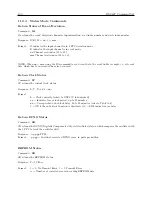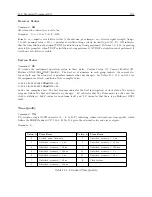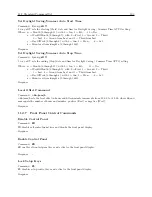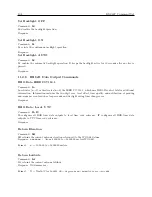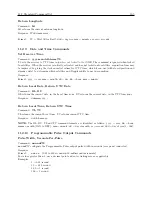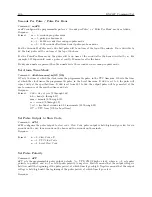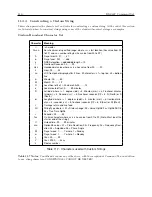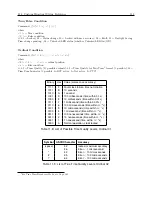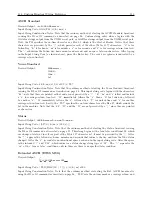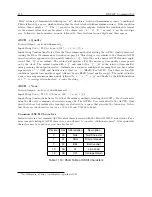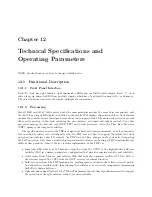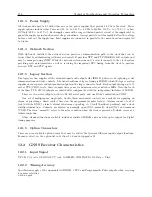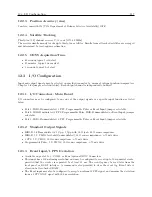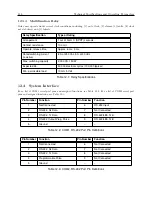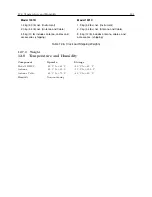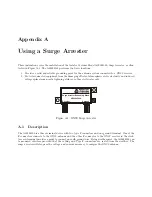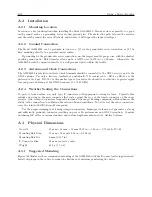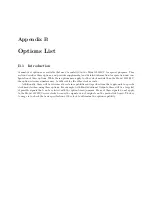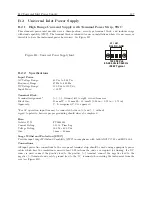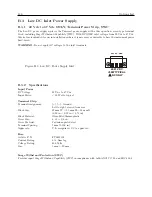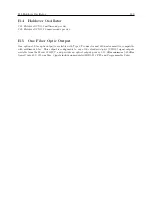
114
RS-232C Command Set
“H0A” is line feed. Immediately following is a “03”, which is a “locked with maximum accuracy” conditional.
This is followed by a space, which indicates that the clock is locked with maximum accuracy. If the condition
is false, then it prints a “?”. The “/:” separates the true/false outputs. Outside the conditional statement
are the normal values that are broadcast at the chosen rate. “y”, “d”, “h”, “m” and “s” are the two-digit
year, Julian day, hours, minutes, seconds, followed by three fractional second digits and three spaces.
ASCII + Quality
Desired Output:
<
soh
>
ddd:hh:mm:ssQ
C
Input String Code: /T01/d:/h:/m:/s/
{
01? /:./:
∗
/:#/;?/
}
/r
Input String Constructions Notes: Note that the ordinary method of starting the ASCII + Quality broadcast
is using the B6 or O6 command as described on page 96. This string is very similar to the Standard ASCII
described earlier appended with a quality indicator, “Q”. All of the notes under ASCII Standard apply,
except that “Q” is an ordinal. The ordinal will produce all of the necessary time quality values passed
on by the clock. The ordinal begins with a “
{
” and ends with a “
}
”. “01” is the selected (time quality)
value governing the output character. Ordinals are a sequence conditional, meaning that you have values
separated by a “/:” (OR), and (in this case) at last is a “/;” (ELSE). For ASCII + Qual, there are four OR
conditions (specific time quality ranges) followed by one ELSE (worst quality range). The initial ordinal is
a space, meaning maximum time quality followed by a “.”, a “*”, a “#” and finally by the ELSE condition
of a “?”. A carriage return line feed “r” ends the string.
ASCII + Year
Desired Output:
<
soh
>
yyyy ddd:hh:mm:ssQ
C
Input String Code: /T01/Y d:/h:/m:/s/
{
01? /:./:
∗
/:#/;?/
}
/r
Input String Constructions Notes: Note that the ordinary method of starting the ASCII + Year broadcast is
using the B8 or O8 command as described on page 96. The ASCII + Year is identical to the ASCII + Qual
described above but includes the four-digit year followed by a space that precedes the Julian day. Notice
that there are two characters for year: y (0 to 99) and Y (2000 to 2xxx).
Common ASCII Characters
Listed below are a few common ASCII control characters used with the Model 1201B/C series clocks. For a
more complete listing of ASCII characters, you will need to consult a additional sources
. Other printable
characters may be typed in as seen on a keyboard.
Decimal
Hex
Abbreviation
Description
0
00
NUL
Null Character
1
01
SOH
Start of Header
7
07
BEL
Bell (sound)
10
0A
LF
Line Feed
13
0D
CR
Carriage Return
Table 11.10: Short Table of ASCII Characters
2
See Wikipedia, at http://en.wikipedia.org/wiki/ASCII
Содержание 1201B
Страница 4: ...iv ...
Страница 153: ...B 7 Four Fiber Optic Outputs 135 Figure B 4 Jumper Locations ...
Страница 155: ...B 8 8 Channel High Drive IRIG B Amplifier 137 Figure B 5 8 High Drive Outputs Jumper Locations ...
Страница 171: ...B 10 Four Additional Outputs and Dry Contacts 25 50 Vdc 153 Figure B 7 Option Connector Signal Locations ...
Страница 222: ...Appendix E Statement of Compliance The following page is a statement of compliance that includes Model 1201B and 1201C ...

